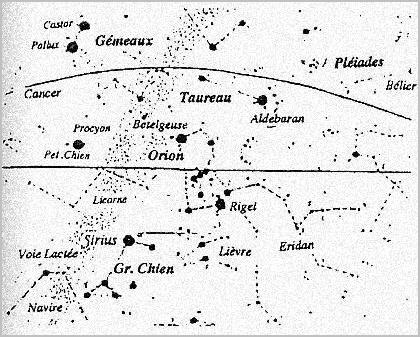
An assembly of sacred
TABLE OF CONTENTS
Home page
The awaited return of the most obvious seasonal signal
The "brilliant" sectors of the sky
An assembly of sacred images
Figures portrayed
by stars in the night,
by nature "dramatic" figures
Why make reference to
seasonal stars.
Measuring time in "moons"
When lunar imagery is combined
with stellar imagery to compose
a "mythical cinema"
The human condition
and its development
in the
collective memory
More
French version
Bordering the Milky Way
What is obvious in India (cf Tilak on Orion and the Vedas) has been forgotten in the West. Among easily recognizable configurations, this sector has the largest number of first and second magnitude stars: Aldebaran (red), Bellatrix and Betelgeuse, Orion’s Belt, Rigel, Castor and Pollux in the Milky Way and the inescapable Sirius (Double sun, bluish white), the most brilliant star in the sky.

The "brilliant" sectors of the sky

A repertory of sacred images
The names given to certain stars demonstrate their particular interest and that they stimulated man’s imagination. These figures announce special seasons and are marked by impressive rites, often including sacrifices. Logically they appear as personages, sacred objects or settings (nearly always nocturnal) in grand mythical sequences vehicled in the northern hemisphere by millennia of oral tradition. A glance at the names of these constellations show that the images indicated appear in a large number of myths, fundamental religious texts, tales and legends known to all.
The series, in order of appearance, is interpreted in various ways depending on the where, the animals concerned and the era:
The fine little group of the Pleiades
7 stars, 9 for those with the sharpest eyesight.
This selected Group is a "precursor" and consequently an "announcer" of sacred acts, attentively watched for and clearly recognized as a source of myths: "ampla fabula sorores nobilitat": "a vast set of legends has made the seven sisters famous" (Aratos)
The main texts consulted show that observers saw the Pleiades as:
- a swarm of bees or butterflies
- a group or flight of small birds (in Greece: doves; Europe: chicklets, the hen and chicks was common in old European languages)
- a bouquet of flowers,
- a bunch of brilliant fruit, in Greece (and still in Provençal French: the Miograne) an open Grenadine,
- 7 little ones, small animals, small children or 7 dwarfs (Pygmies), 7 (or 9) celestial maidens, most often considered as the children of the major figure that follows, animal or human.
A very ancient interpretation linked to cannibalistic sacrificial rites (maintained in Aztec ceremonies) has the appearance of the big figure of Orion, which follows the Pleiades, as the arrival of the Big Hunter (Agr, Ogr, wild hunt or Agraani in India: Orion Hunter) who pursues
7 little ones to devour them.
- a distant, bustling population center, anthill, celestial city with 7 entries (Pleias Heptaporos) or cave-riddled mountain of the 7 meditating sages.